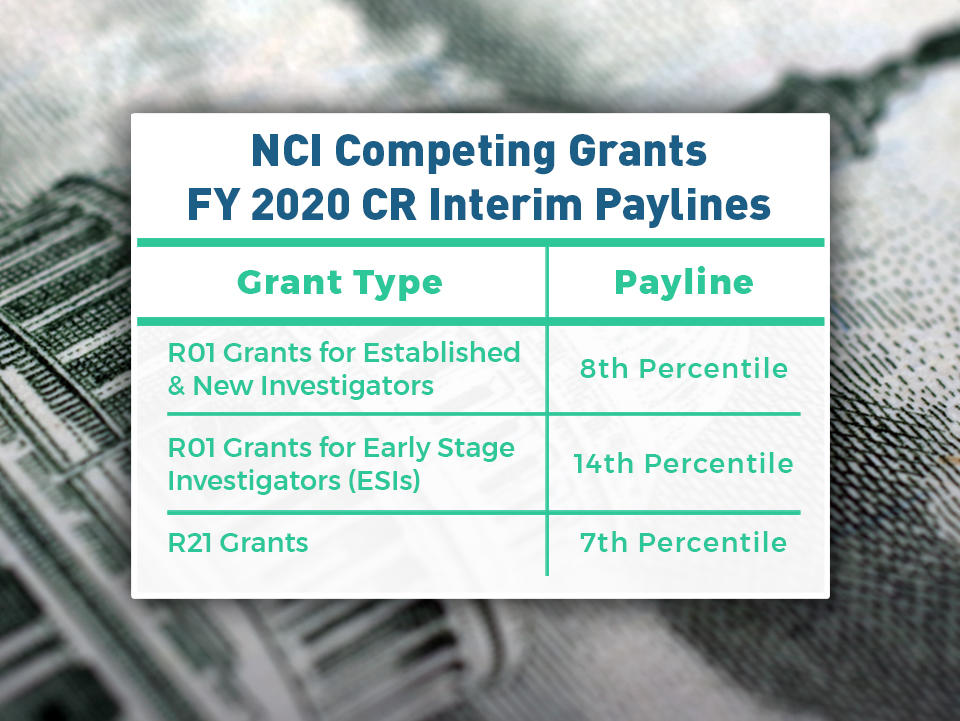Living in Budget Limbo Under a Continuing Resolution
, by Patrick McGarey
Patrick McGarey, NCI’s Associate Director for Finance and Legislation, provides background and an overview of how federal agencies operate under a continuing resolution. This blog highlights policies that are especially relevant to current and future NCI-funded researchers, including what the fiscal year 2020 interim budget means for competing and noncompeting grants policy.
For federal agencies like NCI, a continuing resolution—commonly called a CR—is a time of ongoing budget uncertainty. Since October 1, NCI has been conducting its programs and operations under a CR.
What’s a CR? According to the Government Accountability Office, the arm of Congress that analyzes and audits federal programs, a continuing resolution is “an appropriation act that provides budget authority for federal agencies … to continue in operation when Congress and the President have not completed action on the regular appropriation acts.”
In sum, a CR is usually short-term legislation to keep the government operating if Congress and the President cannot agree on a budget before the fiscal year begins each October 1.
With one notable exception, during the past 20 years, some or all of the federal government operated under a CR for portions of the fiscal year (FY). For NCI, FY 2019 was that notable exception. For the fiscal year that just concluded, Congress passed legislation to fund about 60% of federal discretionary programs, including NCI, before the fiscal year began. Thus, for FY 2019, NCI received a full year’s budget as the fiscal year began. That was a welcome event.
One year out of 20 is very infrequent, so operating under a CR as the federal fiscal year begins is the norm for NCI. And, while CRs are common, not all CRs are short term.
For example, during 3 of the past 20 years, some federal agencies operated under a CR for the entire fiscal year. And, during the past two decades, most federal agencies operated for more than one-third of the fiscal year under a CR.
What does a CR mean for the NCI grantee community?
As federal managers at NCI and other agencies know from experience, operating under a CR makes planning our programs difficult, and this challenge may lead to inefficiencies. As an analogy, imagine planning your household budget for the year without knowing what your yearly income will be, or whether your income will rise or fall significantly. You will eventually learn your income level, but that key information may not arrive until 3 or 6 months have passed. Now consider scaling up that challenge to the NCI level, where we receive 13,000 applications and support 7,000 grants annually.
Under the current CR, NCI’s interim funding expires on December 20. We don’t know how much NCI will receive eventually or when our full appropriation from Congress will arrive. Thus, the most prudent approach is to adopt a conservative spending plan and avoid making funding commitments that we can’t sustain when we receive our final appropriation. Other NIH institutes and centers face the same challenge.
NIH Interim Grant Policies during a CR
With this concern in mind, NIH provides guidance to NCI and other institutes about issuing extramural awards during a CR.
The NIH guidance calls for a 10% reduction to noncompeting awards. Although the NIH guidance does not include instructions about funding the many types of competing awards we issue, it instructs NIH institutes “to monitor their expenditures carefully” during the CR. The goal is to ensure we don’t make financial commitments during a CR that NCI can’t sustain when we eventually receive our budget for the remainder of the year.
NCI Interim Noncompeting Grants Policy
NCI follows the NIH CR guidance on noncompeting awards. Thus, under the CR, NCI is issuing noncompeting awards for the following grants at 90%: R01, R21, R33, R35, R37, P01, DP1, UH2/UH3, U01/U19, UM1, and RPG RFAs. The 90% policy only applies to these specific grant mechanisms, and the policy only applies to the noncompeting awards issued while a CR is active.
When NCI has its final appropriation, we will update our policies and consider whether we can restore the remaining 10% of funding to noncompeting grants. You can find details on these and other NIH grant mechanisms on the NIH Activity Codes page.
NCI Interim Competing Grants Policy
The CR complicates NCI’s ability to issue competing grants, as well. As with noncompeting grants, we adopt conservative funding policies for competing awards under a CR.
This approach reduces the financial risk that we can’t sustain the interim funding levels when we eventually receive our budget for the remainder of the year. And, like our noncompeting grants policy, we will re-evaluate competing grant paylines when we receive our final appropriation.
The following table highlights paylines during the CR for NCI’s prominent competing grants mechanisms:
As a comparison, the FY 2020 interim paylines for competing R01 grants issued to established, new, and early-stage investigators and competing R21 grants are identical to the final FY 2019, full-year paylines for these three types of grants.
Further details of these CR grant policies appear on the NCI web site. You can also access an archive of NCI grant policies for prior years. Please continue to follow the NCI Bottom Line Blog, where we will discuss how NCI updates these policies after we receive our final appropriation for FY 2020.

